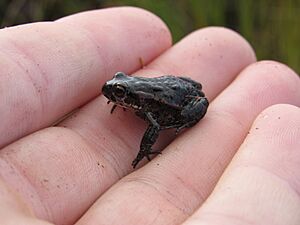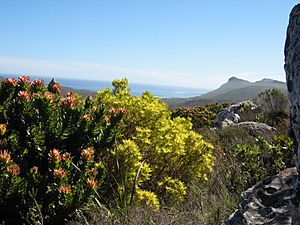Cape mountain toad facts for kids
Quick facts for kids Cape mountain toad |
|
|---|---|
 |
|
| C. rosei in Western Cape, South Africa | |
| Conservation status | |
| Scientific classification | |
| Synonyms | |
|
Bufo rosei Hewitt, 1926 |
The Cape mountain toad (Capensibufo rosei) is a special kind of toad. It is also known as Rose's mountain toad. This small toad lives only in South Africa. Its natural home is a unique plant area called fynbos. Sadly, the Cape mountain toad is in danger because its home is shrinking.
What Does It Look Like?
Female Cape mountain toads are usually bigger than males. Females grow to about 39 millimeters (1.5 inches) long. Males are smaller, reaching about 28 millimeters (1.1 inches).
Their bodies are quite long. They have short back legs and their toes are not webbed. The toad's back can be grey or brown. It might have a few lighter stripes. Its skin is smooth with some small bumps and ridges.
You can see two large glands behind its eyes. These are called parotoid glands. But you cannot see its eardrums, called tympani. This helps tell it apart from a similar toad, Capensibufo tradouwi. The toad's belly is white with dark spots. It has bumpy skin on its lower belly. During the time they breed, a pink patch appears under their tail.
Where Does It Live?
The Cape mountain toad lives only in the Western Cape province of South Africa. This area is southwest of the Breede River. It includes the Cape Peninsula. This region has hills and a Mediterranean climate. This means it has rainy winters.
The area is famous for its special plant life called fynbos. Fynbos is a type of heathland. It has small evergreen plants like proteas. There are also many types of heather plants, herbs, and grasses. You won't find many large trees here.
Cape mountain toads live at different heights. They can be found from 60 meters (200 feet) to 1,600 meters (5,200 feet) above sea level. Most of them live higher up, above 400 meters (1,300 feet).
How Does It Live?
Cape mountain toads breed when the winter rains come. This is when temporary shallow pools of water form. Interestingly, the male toads do not make calls to attract females. This might be the only amphibian in South Africa that doesn't have a voice!
The female toad lays about one hundred eggs. These eggs are in a jelly-like string. The eggs hatch in about twelve days. The tiny tadpoles grow depending on how warm it is and how much food they can find. They change into young toads about six weeks after hatching. This change is called metamorphosis.
Why Is It Important?
The Cape mountain toad only lives in the fynbos heathland. It doesn't seem to adapt well when its home changes. This includes when new plants that aren't from the area grow. It also struggles when the heathland is burned, which sometimes happens.
Even though you can find many of them in temporary pools during breeding season, they only live in about 2% of the places that seem right for them. They are known from only two main spots. They are missing from many areas where they used to live. For example, a group of these toads was found on Table Mountain in 1927. But no one has seen them there for many decades. So, we don't know if that group is still around.



